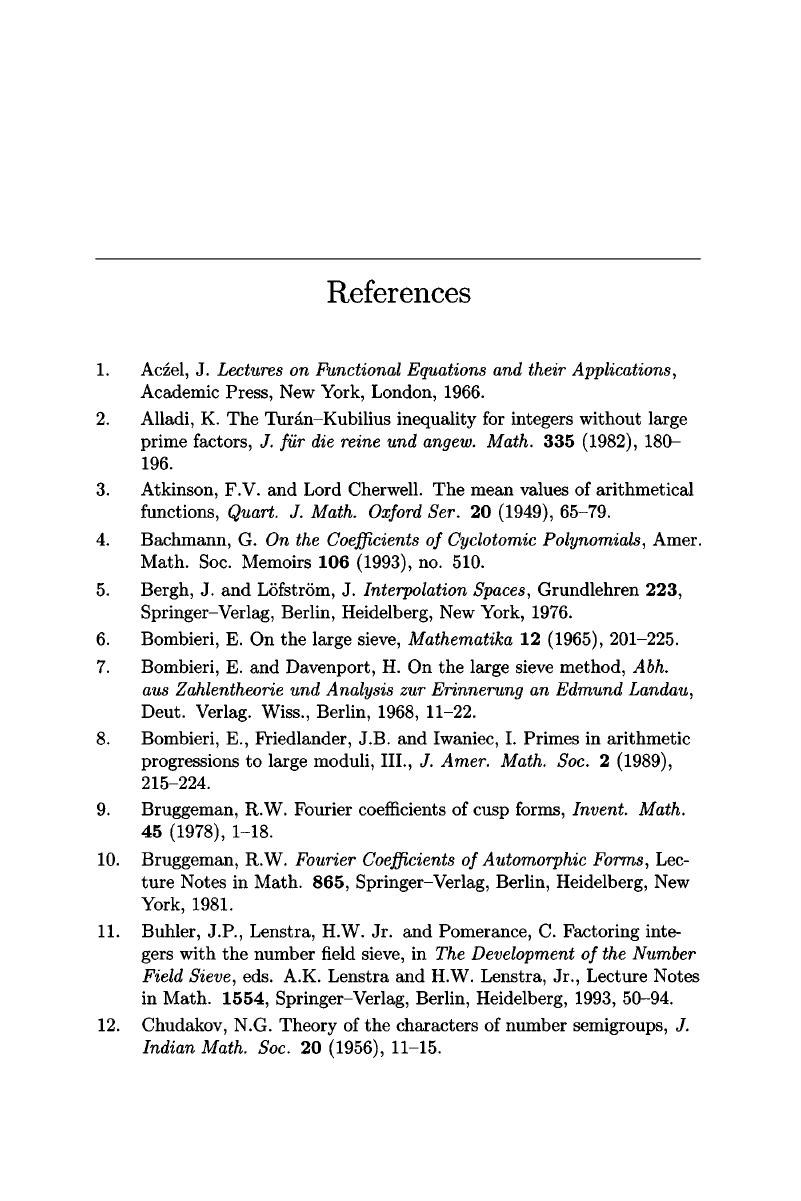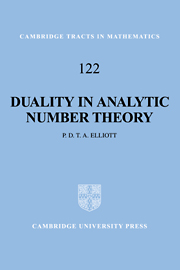Book contents
- Frontmatter
- Contents
- Acknowledgements
- Preface
- Notation
- Introduction
- 0 Duality and Fourier analysis
- 1 Background philosophy
- 2 Operator norm inequalities
- 3 Dual norm inequalities
- 4 Exercises: Including the Large Sieve
- 5 The method of the stable dual (1): Deriving the approximate functional equations
- 6 The method of the stable dual (2): Solving the approximate functional equations
- 7 Exercises: Almost linear, Almost exponential
- 8 Additive functions of class ℒα. A first application of the method
- 9 Multiplicative functions of the class ℒα: First Approach
- 10 Multiplicative functions of the class ℒα: Second Approach
- 11 Multiplicative functions of the class ℒα: Third Approach
- 12 Exercises: Why the form?
- 13 Theorems of Wirsing and Halász
- 14 Again Wirsing's Theorem
- 15 Exercises: The prime number theorem
- 16 Finitely distributed additive functions
- 17 Multiplicative functions of the class ℒα. Mean value zero
- 18 Exercises: Including logarithmic weights
- 19 Encounters with Ramanujan's function τ(n)
- 20 The operator T on L2
- 21 The operator T on Lα and other spaces
- 22 Exercises: The operator D and differentiation. The operator T and the convergence of measures
- 23 Pause: Towards the discrete derivative
- 24 Exercises: Multiplicative functions on arithmetic progressions. Wiener phenomenon
- 25 Fractional power Large Sieves. Operators involving primes
- 26 Exercises: Probability seen from number theory
- 27 Additive functions on arithmetic progressions: Small moduli
- 28 Additive functions on arithmetic progressions: Large moduli
- 29 Exercises: Maximal inequalities
- 30 Shift operators and orthogonal duals
- 31 Differences of additive functions. Local inequalities
- 32 Linear forms in shifted additive functions
- 33 Exercises: Stability. Correlations of multiplicative functions
- 34 Further readings
- 35 Rückblick (after the manner of Johannes Brahms)
- References
- Author index
- Subject index
References
Published online by Cambridge University Press: 05 November 2011
- Frontmatter
- Contents
- Acknowledgements
- Preface
- Notation
- Introduction
- 0 Duality and Fourier analysis
- 1 Background philosophy
- 2 Operator norm inequalities
- 3 Dual norm inequalities
- 4 Exercises: Including the Large Sieve
- 5 The method of the stable dual (1): Deriving the approximate functional equations
- 6 The method of the stable dual (2): Solving the approximate functional equations
- 7 Exercises: Almost linear, Almost exponential
- 8 Additive functions of class ℒα. A first application of the method
- 9 Multiplicative functions of the class ℒα: First Approach
- 10 Multiplicative functions of the class ℒα: Second Approach
- 11 Multiplicative functions of the class ℒα: Third Approach
- 12 Exercises: Why the form?
- 13 Theorems of Wirsing and Halász
- 14 Again Wirsing's Theorem
- 15 Exercises: The prime number theorem
- 16 Finitely distributed additive functions
- 17 Multiplicative functions of the class ℒα. Mean value zero
- 18 Exercises: Including logarithmic weights
- 19 Encounters with Ramanujan's function τ(n)
- 20 The operator T on L2
- 21 The operator T on Lα and other spaces
- 22 Exercises: The operator D and differentiation. The operator T and the convergence of measures
- 23 Pause: Towards the discrete derivative
- 24 Exercises: Multiplicative functions on arithmetic progressions. Wiener phenomenon
- 25 Fractional power Large Sieves. Operators involving primes
- 26 Exercises: Probability seen from number theory
- 27 Additive functions on arithmetic progressions: Small moduli
- 28 Additive functions on arithmetic progressions: Large moduli
- 29 Exercises: Maximal inequalities
- 30 Shift operators and orthogonal duals
- 31 Differences of additive functions. Local inequalities
- 32 Linear forms in shifted additive functions
- 33 Exercises: Stability. Correlations of multiplicative functions
- 34 Further readings
- 35 Rückblick (after the manner of Johannes Brahms)
- References
- Author index
- Subject index
Summary

- Type
- Chapter
- Information
- Duality in Analytic Number Theory , pp. 321 - 332Publisher: Cambridge University PressPrint publication year: 1997

